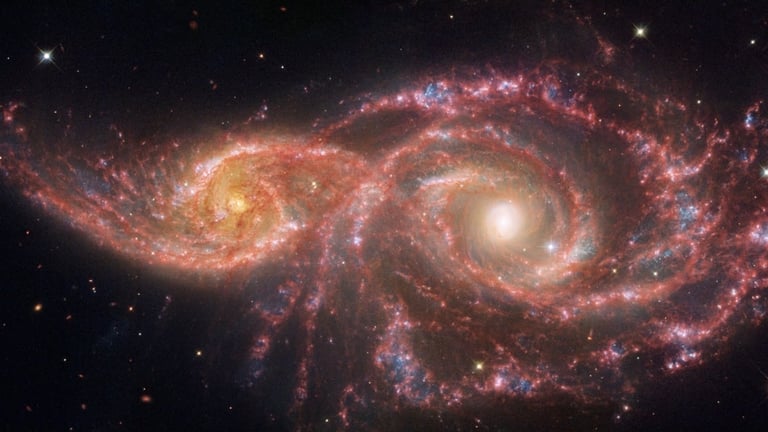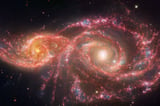NASA's Webb and Hubble Capture Stunning Intertwined Spiral Galaxies in Cosmic Dance
October 31, 2024
NASA's Webb and Hubble space telescopes have collaborated to capture the highest resolution image of the spiral galaxies IC 2163 and NGC 2207, utilizing a blend of mid-infrared, visible, and ultraviolet light.
The interaction between NGC 2207 and IC 2163 is a long-term cosmic dance, characterized by their gravitational pull as they swing around each other.
Evidence of their interaction is visible in shock fronts, characterized by bright red lines that indicate past collisions and material collisions between the galaxies.
The image showcases vibrant blue, pink, and white regions that highlight active star-forming areas, with mini starbursts indicating rapid star formation events.
As these galaxies continue to interact, they may eventually merge their cores, reshaping their structures and potentially reducing star formation as their gas and dust are depleted.
Currently, both galaxies are experiencing a high rate of star formation, producing approximately two dozen new stars the size of our sun each year.
Despite the apparent chaos of their interaction, the gravitational forces at play compress dust and gas, fostering conditions that promote star creation.
IC 2163, the smaller galaxy, has recently passed behind the larger NGC 2207, creating a visual effect that makes it appear intertwined with its larger counterpart.
The gravitational interaction has distorted the galaxies' spiral arms, leading to tidal extensions that resemble 'eyelids' and additional tendrils between their cores.
This cosmic spectacle prompts philosophical reflections on the vastness of the universe and our place within it, echoing Friedrich Nietzsche's thoughts on gazing into the abyss.
These galaxies are currently merging, a process that will unfold over approximately one billion years, ultimately leading to the formation of a single, larger galaxy.
The collaboration between the James Webb Space Telescope and the Hubble Space Telescope underscores their vital roles in enhancing our understanding of cosmic structures and the dynamic nature of galactic interactions.
Summary based on 7 sources
Get a daily email with more Science stories
Sources

Mashable • Nov 1, 2024
Webb and Hubble telescopes provide a preview to galactic cannibalism
Gizmodo • Oct 31, 2024
Hubble and Webb Team Up to Reveal 'Bloody Eyes' Glaring at Earth
Digital Trends • Oct 31, 2024
Cosmic eyes stare out from space in Webb and Hubble image | Digital Trends